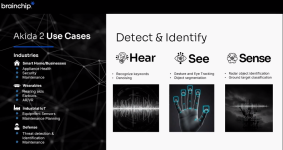#edgeai #moschipdigitalsky #adas #moschip #genai #edgeai #iot #genaiot #adas #automotive #driverbehavior #driverdistraction #fleetmanagement | MosChip®
[#2 of 75+] See MosChip’s #EdgeAI Driver Drowsiness & Behavior Model in action. This Edge AI base model is part of the #MosChipDigitalSky GenAIoT technology suite, ready to be deployed for your next AI/ML based solution. Hey, have you checked out our #ADAS model? Head over to our page and...
Interesting theme 1st half of 2022, I wonder what else might appear soon.

BrainChip and MosChip Demonstrate Neural Processor IP at IESA Summit
BrainChip and MosChip demonstrate neural processor IP and ASICs at IESA AI Summit, showcasing high-performance, low-power AI solutions for smart devices.

